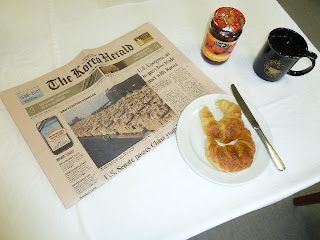I'm on Amber for the voyage, not the ports. Just as well after the last few days. But first, back to the East China Sea.
Not long ago, we were anxious about fishing boats and pirates. Now we're anxious about, as the chief mate calls them, "suicidal $&@?! fishing boats."
On the radar are Chinese fishing fleets, two of many through which Amber steers.


I wasn't on the bridge when one came within metres. The second mate looked quite shaken when I saw him shortly after. The shots below give an idea of how close they get.



The Filipinos - the captain's father and brother were fishermen - are sympathetic, although very worried about collisions. As Elmer says, "The fishermen have children." The Croatians are less charitable.
One Chinese port, Xiamen (which the British called Amoy) has been dropped. We arrive in Shanghai - the world's busiest port - in the dark and, twelve hours later, depart in early gloom. Before containers, ships docked right in the city, which, between the wars, was delightfully, sordidly, famously wicked ("It took more than one man to change my name to Shanghai Lily"). The new terminal is a hundred kilometres away. No-one has shore leave as there's no point.
About 0630, this is the view from Amber's port side. Exciting, eh?
Again this morning, Jayson, who's vague about geography, asks if we're near the Great Wall. However, he does know that Drumheller, Alberta, where his wife worked, is in Canada and there's a dinosaur museum.
An off-duty crewman watches the gangway readied for sea.
The next day, Pusan or Busan, South Korea, much like Shanghai and more rain. In the chief mate's words, "grey, grey, grey." All that's vaguely oriental are receding hills, which, at a stretch, remind me of Chinese paintings.


In Pusan, Amber returns to her birthplace. Amber is a very basic ship, so it makes sense she and her sister, Coral, were conceived by Hanjin Heavy Industries' 'basic design team'. Amber's keel was laid May 30, 2008; she was launched a month-and-a-half later on July 14 and handed over to CMA CGM September 5. They don't waste time here, which is why cheap - cheap relatively speaking - container ships flood from Far East shipyards and not Europe or North America.
Lee Yeong-Im, wife of a Hanjin manager, was named the ship's 'godmother'. In a traditional Korean ceremony, she cuts a rope linking the ship to the land. This represents the cutting of the umbilical cord.

As for my stay in Pusan, a bureaucratic foulup results in no shore pass for me. The downpour and effort to get into the city and back mean I wouldn't go anyway. Besides, I rationalize, I've had plenty of time in both Koreas.

For mid-morning coffee, 'Cookie' cheers me up with hot croissants and I have a paper, a rare treat thanks to the agent. Good news: hostages on the hijacked Italian ship mentioned in my last post have been freed by British and U.S. naval forces.

Departing Pusan, Captain 'Boni' and pilot demonstrate why sailors often prefer completely enclosed wings.

We pass one of two rather stylish lights at the terminal entrance. The door at the base gives an idea of size.

Last picture, admittedly not a good one in the fog, as we leave South Korea: straight from the shipyard, CMA CGM Nevada. She's riding high because there's no cargo. What you see above the main deck are structures separating bays for containers. Nevada can carry a little less than three times as many containers as Amber. CMA CGM must be hoping business is better than the Las Vegas real estate market.

We're crossing the Sea of Japan, as the Japanese call it, or East Sea, according to the Koreans. All being well, our arrival at the Panama Canal pilot station will be sixteen days and 8146.2 nautical miles (9374.5 miles or 15,086.8 kilometres) from Pusan.





